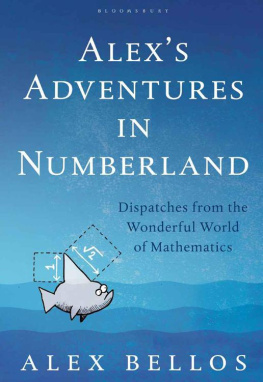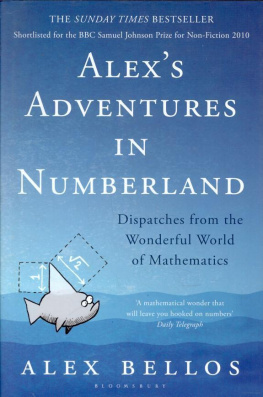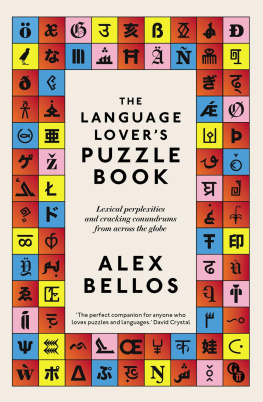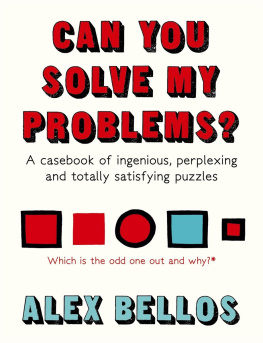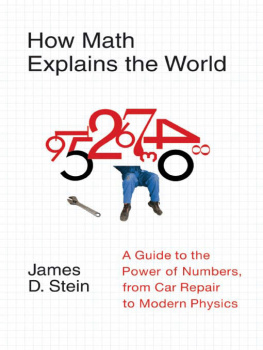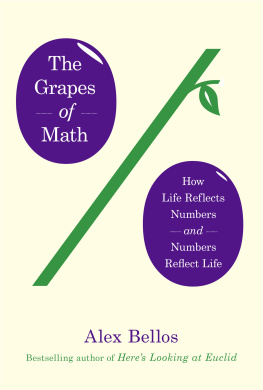Simon & Schuster
1230 Avenue of the Americas
New York, NY 10020
www.SimonandSchuster.com
Copyright 2014 by Alex Bellos
Cartoons 2014 by The Surreal McCoy
Mathematical diagrams 2014 by Simon Lindo
All rights reserved, including the right to reproduce this book or portions thereof in any form whatsoever. For information address Simon & Schuster Subsidiary Rights Department, 1230 Avenue of the Americas, New York, NY 10020.
First Simon & Schuster hardcover edition June 2014
SIMON & SCHUSTER and colophon are registered trademarks of Simon & Schuster, Inc.
The Simon & Schuster Speakers Bureau can bring authors to your live event. For more information or to book an event contact the Simon & Schuster Speakers Bureau at 1-866-248-3049 or visit our website at www.simonspeakers.com.
Interior design by Libanus Press
Jacket design by Oliver Munday
Author photograph: Original photograph Michael Duerinckx; Artwork by the Concorde TSP Solver iPhone app, in which a single line connects 29,421 dots.
Library of Congress Cataloging-in-Publication Data
Bellos, Alex, 1969 author.
The grapes of math: how life reflects numbers and numbers reflect life / Alex Bellos ; illustrations by the Surreal McCoy.
pages cm
1. MathematicsMiscellanea. I. Title.
QA99.B195 2014
510dc23
2014012104
ISBN 978-1-4516-4009-0
ISBN 978-1-4516-4012-0 (ebook)
Contents
Introduction
Mathematics is a joke.
Im not being funny.
You need to get a joke just as you need to get math.
The mental process is the same.
Think about it. Jokes are stories with a setup and a punch line. You follow them carefully until the payoff, which makes you smile.
A piece of math is also a story with a setup and a punch line. Its a different type of story, of course, in which the protagonists are numbers, shapes, symbols and patterns. Wed usually call a mathematical story a proof, and the punch line a theorem.
You follow the proof until you reach the payoff. Whoosh! You get it! Neurons go wild! A rush of intellectual satisfaction justifies the initial confusion, and you smile.
The ha-ha! in the case of a joke and the aha! in the case of math describe the same experience, and this is one of the reasons why understanding mathematics can be so enjoyable and addictive.
Like the funniest punch lines, the finest theorems reveal something you are not expecting. They present a new idea, a new perspective. With jokes, you laugh. With math, you gasp in awe. It was precisely this element of surprise that made me fall in love with math as a child. No other subject so consistently challenged my preconceptions.
The aim of this book is to surprise you, too. In it, I embark on a tour of my favorite mathematical concepts, and explore their presence in our lives. I want you to appreciate the beauty, utility and playfulness of logical thought.
My previous book, Here's Looking at Euclid , was a journey into mathematical abstraction. This time I come down to earth: my concern is as much the real world, reflected in the mirror of math, as it is the abstract one, inspired by our physical experiences.
First, I put humans on the couch. What are the feelings we have for numbers, and what triggers these feelings? Then I put numbers on the couch, individually and as a group. Each number has its own issues. When we engage with them en masse, however, we see fascinating behavior: they conduct themselves like a well-organized crowd.
We depend on numbers to make sense of the world, and have done so ever since we started to count. In fact, perhaps the most surprising feature of mathematics is how extraordinarily successful it has been, and continues to be, in enabling us to understand our surroundings. Civilization has progressed as far as it has thanks to discoveries about simple shapes like circles and triangles, expressed pictorially at first, and later in the vernacular of equations.
Math, I would argue, is the most impressive and longest-running collective enterprise in human history. In the following pages I follow the torch of discovery from the Pyramids to Mount Everest, from Prague to Guangzhou, and from the Victorian drawing room to a digital universe of self-replicating creatures. We will meet swashbuckling intellects, including familiar names from antiquity and less familiar names from the present day. Our cast includes a cravat-wearing celebrity in India, a gun-toting private investigator in the United States, a member of a secret society in France, and a spaceship engineer who lives near my London flat.
As we roam across physical and abstract worlds, we will probe well-known concepts, like pi and negative numbers, and encounter more enigmatic ones, which will become our confidants. We will marvel at concrete applications of mathematical ideas, including some that actually are made of concrete.
You dont need to be a math whiz to read this book. Its aimed at the general reader. Each chapter introduces a new mathematical concept, and assumes no previous knowledge. Inevitably, however, some concepts are more stretching than others. The level sometimes reaches that of an undergraduate degree, and, depending on your mathematical proficiency, there may be moments of bewilderment. In these cases, skip to the beginning of the next chapter, where I reset the level to elementary. The material might make you feel a bit dizzy at first, especially if it is new to you, but thats the point. I want you to see life differently. Sometimes the aha! takes time.
If all this sounds a bit serious, it isnt. The emphasis on surprise has made math the most playful of all intellectual disciplines. Numbers have always been toys, as much as they have been tools.
Not only does math help you understand the world better, it helps you enjoy it more, too.
Alex Bellos
January 2014
CHAPTER ONE
Every Number Tells a Story
Jerry Newport asked me to pick a four-digit number.
2761, I said.
Thats 11 251, he replied, reciting the numbers in one continuous, unhesitant flow.
2762. Thats 2 1381.
2763. Thats 3 3 307.
2764. Thats 2 2 691.
Jerry is a retired taxi driver from Tucson, Arizona, with Aspergers syndrome. He has a ruddy complexion and small blue eyes, his large forehead sliced by a diagonal comb of dark blond hair. He likes birds as well as numbers, and when we met he was wearing a flowery red shirt with a parrot on it. We were sitting in his living room, together with a cockatoo, a dove, three parakeets and two cockatiels, which were also listening to, and occasionally repeating, our conversation.
As soon as Jerry sees a big number, he divides it up into prime numbers, which are those numbers2, 3, 5, 7, 11...that can be divided only by themselves and 1. This habit made his former job driving cabs particularly enjoyable, since there was always a number on the license plate in front of him. When he lived in Santa Monica, where license numbers were four and five digits long, he would often visit the four-story car park of his local mall and not leave until he had worked through every plate.
In Tucson, however, car numbers are only three digits long. He barely glances at them now.
If the number is more than four digits Ill start to pay attention to it. If its four digits or less, its roadkill. It is! he remonstrated. Come on! Show me something new!
Aspergers is a psychological disorder in which social awkwardness can coexist with extreme abilities, such as, in Jerrys case, an extraordinary talent for mental arithmetic. In 2010 he competed at the Mental Calculation World Cup in Germany having done no preparation. He won the overall title of Most Versatile Calculator, the only contestant to score full marks in the category where 19 five-digit numbers have to be decomposed into their constituent primes in ten minutes. No one else got even close.
Next page

